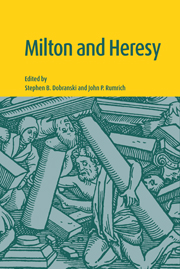Book contents
- Frontmatter
- Contents
- List of contributors
- Acknowledgments
- Abbreviations
- Introduction: Heretical Milton
- PART I HERETICAL THEOLOGY
- PART II HERESY AND CONSEQUENCES
- PART III HERESY AND COMMUNITY
- 7 Licensing Milton's heresy
- 8 Milton and the rationale of insulting
- 9 Treason against God and state: blasphemy in Milton's culture and Paradise Lost
- 10 The politics of performance in the inner theater: Samson Agonistes as closet drama
- PART IV READERS OF HERESY
- Index
10 - The politics of performance in the inner theater: Samson Agonistes as closet drama
Published online by Cambridge University Press: 10 October 2009
- Frontmatter
- Contents
- List of contributors
- Acknowledgments
- Abbreviations
- Introduction: Heretical Milton
- PART I HERETICAL THEOLOGY
- PART II HERESY AND CONSEQUENCES
- PART III HERESY AND COMMUNITY
- 7 Licensing Milton's heresy
- 8 Milton and the rationale of insulting
- 9 Treason against God and state: blasphemy in Milton's culture and Paradise Lost
- 10 The politics of performance in the inner theater: Samson Agonistes as closet drama
- PART IV READERS OF HERESY
- Index
Summary
This chapter examines Samson Agonistes in terms of the genre of the closet drama, a printed play designed to be read rather than staged, which had also served during the late Renaissance and Civil War years in England as a vehicle for political criticism. In his lengthy Memoirs of Milton, Francis Peck observed that Samson Agonistes was written “exactly on the same plan” as George Buchanan's Baptistes sive Calumnia, a connection supported by his references to Dagonalia and Baptistes, two of Milton's proposed tragedies in the Trinity College Manuscript. Peck, moreover, attributed to Milton a seventeenth-century translation of Baptistes sive Calumnia, which he interpreted as a topical political allegory Like this translation, entitled Tyrannicall-Government Anatomized, Samson Agonistes negotiates between conflicting traditions as it interweaves biblical and contemporary English history. Furthermore, while its lofty style and classical sources place the text out of reach of the vulgar, Samson Agonistes nevertheless speaks to an anti-establishment culture through its visionary politics, its redefinition of authority and heroic performance, and through the contesting interpretations it presents and encourages.
Though regarded as a type of Christ in the exegetical literature of the period, as Thomas Taylor's Christ Revealed reminds us, the tragic figure of Samson was for the disillusioned revolutionary a necessary successor to the inimitable character of Christ in Paradise Regained. In the seventeenth century, Samson was frequently invoked (in name and meaning): the “over-mastred” Charles I is portrayed as Samson in Eleanor Douglas's Samsons Legacie; Milton creates a prophetic vision of the “noble and puissant Nation rousing herself like a strong man after sleep” in Areopagitica (CP II: 558); and the imprisoned John Lilburne characterizes his fight for freedom in The Resolved mans as a “Sampson like” struggle.
- Type
- Chapter
- Information
- Milton and Heresy , pp. 199 - 216Publisher: Cambridge University PressPrint publication year: 1998
- 4
- Cited by

